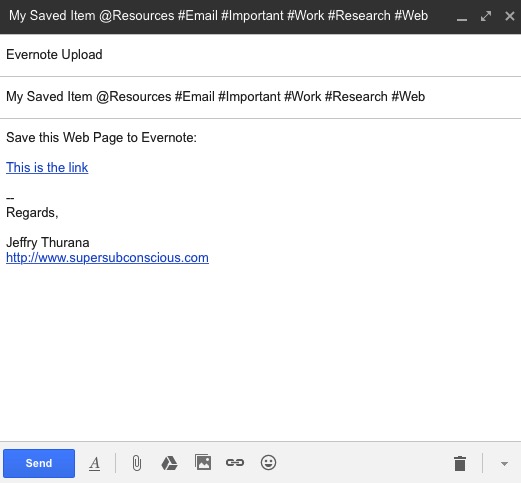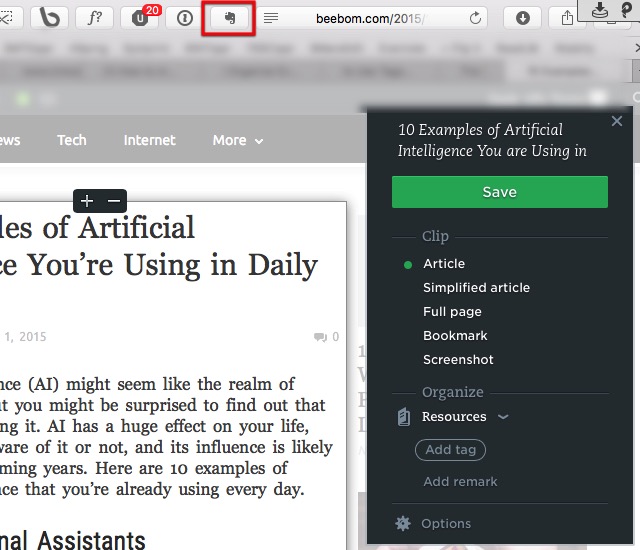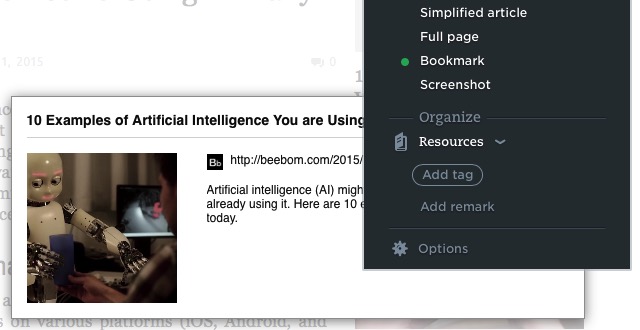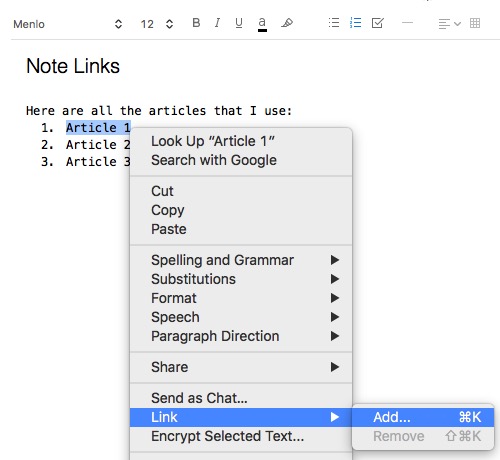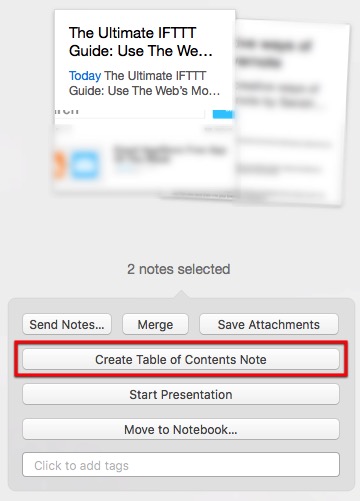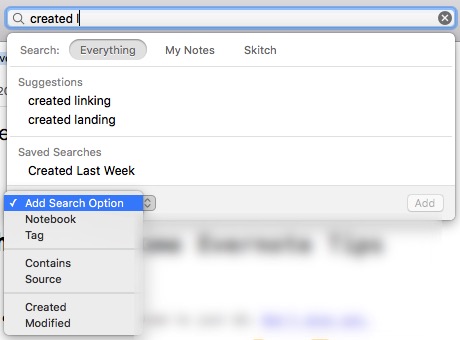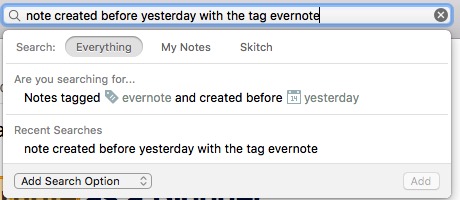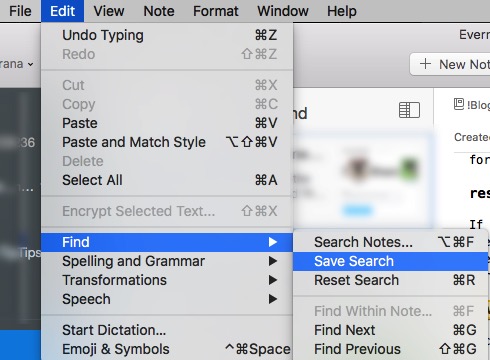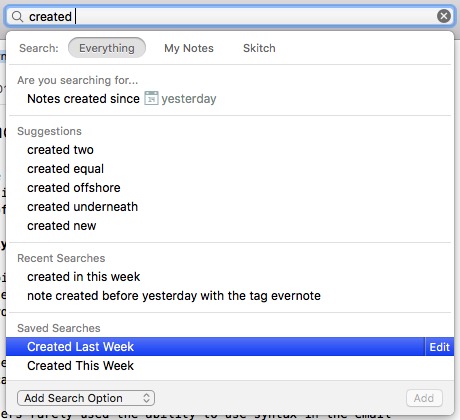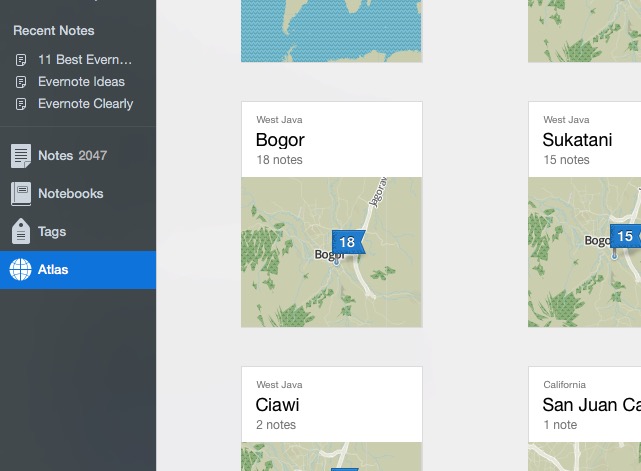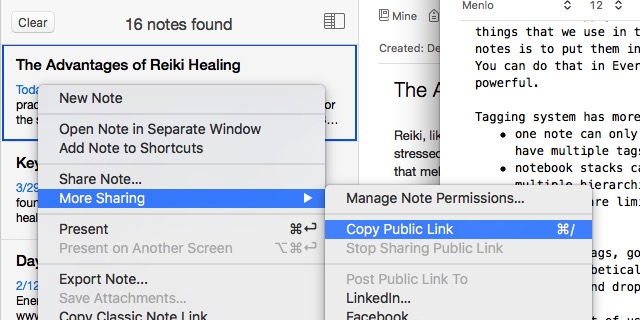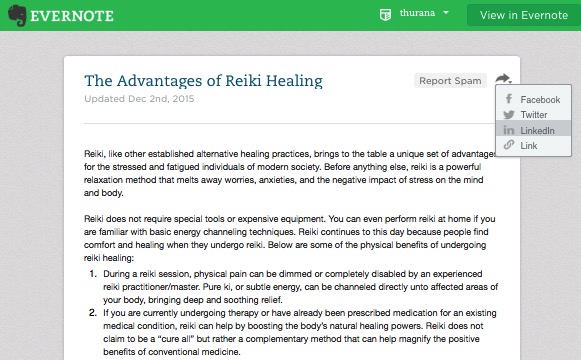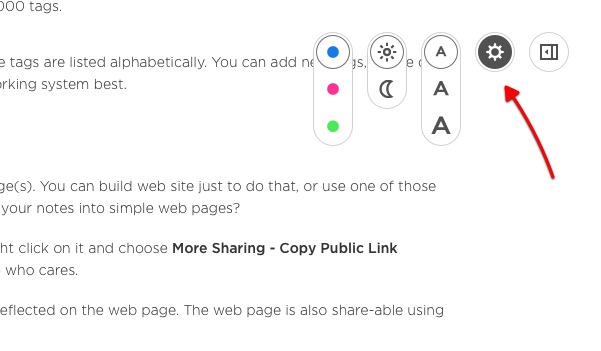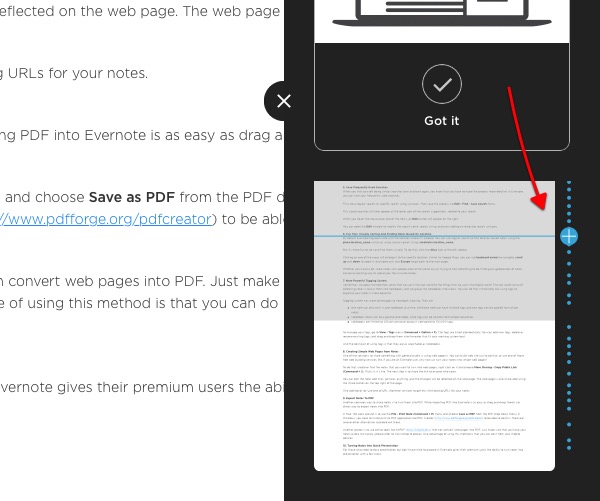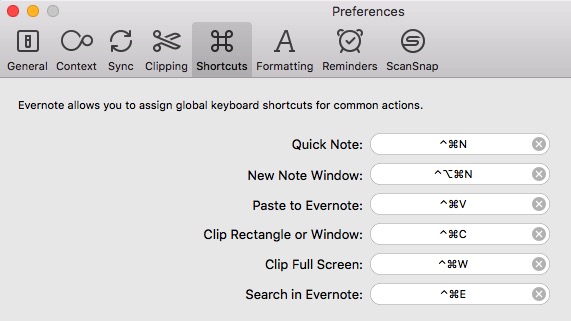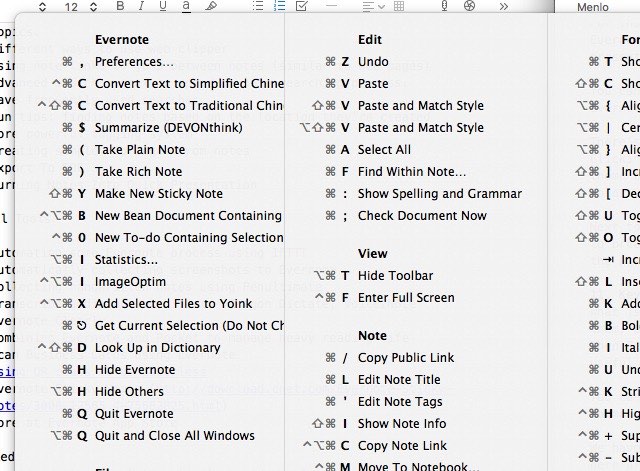1. Using Syntax to Automatically Sort Emailed Notes
Evernote gives its users the ability to create notes by sending emails to a particular address. Upon sign up, every user will be given his/her special Evernote email address. Should you forget your email, you can look it up via Account Info – More Account Settings – Account Summary. It’s also a good idea to add the address to your synchronized Contacts/Address Book, so you don’t have to memorize it and can access it fast from any device you are on. But most “email to Evernote” users have rarely used the ability to use syntax in the email subject. There are several advantages of using these syntaxes:
you can modify the title of the created notes you can sort the notes into specific notebooks you can also add related tags to the notes
The basic format of email syntax is: Title @Notebook #Tag1 #Tag2 #Tag3 #TagX So, if you want your emailed item to be saved in Evernote as “My Saved Item” inside a notebook called “Resources”, and you want to tag it with “Email”, “Important”, “Work”, “Research”, and “Web”; then the subject of your email should be: “My Saved Item @Resources #Email #Important #Work #Research #Web” (sans quote).
2. Different Ways to Use Web Clipper
Another favorite way to add notes to Evernote is to use its Web Clipper – a browser extension/add-on available for Safari, Chrome, and Firefox. After you install it, saving web pages into notes is just a click away. Another advantage of using Web Clipper is the ability to choose how you want to clip the web. The basic options are:
Article – save only the article part of the web page.
Simplified article – save the clean version of the article.
Full page – exactly as the name says. Bookmark – save the link with a short description as a bookmark.
Screenshot – save part of the page as an image.
In the first three options, you can highlight the important element of the page by clicking and selecting part of the text that you want to highlight. To remove a highlight, hover to the top left corner of the highlight box, a small “X” button will appear.
3. Creating Note Links to Jump Between Notes
Let’s say you are writing an article and your resource materials are scattered inside Evernote, what is the quickest way to sort through them and open the one that you need? You can take the round trips back and forth to the search box, but that’s ineffective and time-consuming. It would be easier if you can create a note with the link to each and every one of the materials. Evernote comes with a feature called note links to do just that.
To create a note link, do the search to find the note that you want to link to, right-click the note, and choose Copy Note Link.
Then create a new note, write down the name of the note from the previous step, select that written title, right click and choose Add Link (Command + K). Insert the link and click OK. Repeat the process for another link.
But what if you want to link to many notes? Just select multiple notes from the list, and the note area on the right will turn into an options window. Choose Create Table of Contents Note to continue.
And here’s another tip: you can copy and paste between table of contents notes to collect your links.
4. Using Syntax for More Effective Note Search
Once you get the hang of it, clipping web to Evernote can be very addicting. Then suddenly, your Evernote is so filled with tons of notes that finding one manually is next to impossible. Search is a very useful feature of Evernote, but users won’t see its true power until they start using and combining search syntaxes to narrow down the result. The syntaxes can be added visually from the drop down menu at the bottom of the search box.
But you can also enter them manually. These search syntaxes will search all notes:
key1 key2 – with both key1 and key2 words (key here stands for keyword) “key3 key4” – with key3 and key4 in that exact order -key5 – without key5 key6* – that have word(s) start with key6 any:key7 key8 – with either key7 or key8 tag:key9 – with key9 as a tag Intitle:key10 – with key10 within the title created:yyyymmdd – created after that date -created:yyyymmdd – created before that date
Use the combination of quotes, minus signs, and asterisks with the syntaxes for more advanced searches. You can be creative and experiment a little. For example, to search a note related to Evernote and Tips with exact phrase “Advanced Users” in the title, you can use: Evernote Tips Intitle:”Advanced Users”. If that note was created before January 5th, 2015 and use “trick” as a tag but without “fun” tag, add: -created:20150105 tag:trick -tag:fun to the string. Evernote for Mac users have the privilege to use natural language to search, but this ability has not yet available for Windows users.
5. Save Frequently Used Searches
When you find yourself doing similar searches over and over again, you know that you have to make the process more efficient. In Evernote, you can save your frequently used searches. First, do a regular search, or specific search using syntaxes. Then save the process via Edit – Find – Save Search menu.
The saved searches will later appear at the lower part of the search suggestions, related to your search. When you hover the mouse over one of the items, an Edit button will appear on the right.
You can open the Edit window to modify the search name, search string, and even adding or removing search syntaxes.
6. Fun Tips: Visually Sorting and Finding Notes Based On Location
By default, Evernote tag each note with the location where it’s created. You can use regular search to find location-based notes using the place:location_name syntax or using natural search string: created in location_name. But it’s more fun to sort and find them visually. To do that, click the Atlas icon in the left sidebar.
Clicking on one of the maps will enlarge it to the particular location. Similar to Google Maps, you can use keyboard arrows to navigate, scroll up and down to zoom in and zoom out. Use Escape to go back to the main page.
Whether you travel a lot, share notes with people around the world, or just trying to find something to do, finding out geolocation of notes can be an exciting way to spend your few minutes break.
7. More Powerful Tagging System
Sometimes, we apply the common sense that we use in the real world to the things that we use in the digital world. The real world sense of collecting notes is to put them into notebooks, and we group the notebooks into stacks. You can do that in Evernote, but using tags to organize your notes is more powerful. Tagging system has more advantages to notebook stacking. They are:
One note can only exist in one notebook at a time while one note can have multiple tags, and one tag can be applied to multiple notes. Notebook stacks can only go one level deep while tags can be nested into multiple hierarchies. Notebooks are limited to 250 per personal account, compared to 100,000 tags.
To manage your tags, go to View – Tags menu (Command + Option + 3). The tags are listed alphabetically. You can add new tags, delete or rename existing tags, and drag and drop them into the order that fit your working system best.
And the best part of using tags is that they are as searchable as notebooks.
8. Creating Simple Web Pages from Notes
One of the solutions to share something with the general public is using web page(s). You can build a website to do that, or use one of those free web building services. But if you are an Evernote user, it would be easier and faster to turn your notes into web pages. To do that, create or find the notes that you want to turn into web pages, right-click on it and choose More Sharing – Copy Public Link (Command + /). That’s it; it’s live. The next step is to share the link to anyone who cares.
You can edit the note, add links, pictures, anything, and the changes will be reflected on the web page. The web page is also shareable using the Share button at the top right of the page.
Quick Tip: Use one of URL shortener services to get less intimidating URLs for your notes.
9. Export Notes to PDF
Another common way to share notes is to turn them into PDF. While importing PDF into Evernote is as easy as drag and drop, there’s no direct way to export notes to PDF. In Mac, the workaround is to use the File – Print Note (Command + P) menu and choose Save as PDF from the PDF drop-down menu. In Windows, you have to install print to PDF application like PDF Creator to be able to do this. There are several other alternatives available out there.
Another option is to use online tools that can convert web pages to PDF. Just make sure that you have your note’s public link handy (please refer to Tip number 8 above). One advantage of using this method is that you can do it from your mobile devices.
10. Turning Notes into Quick Presentation
For those who need to do a presentation but don’t have time to prepare it, Evernote gives their premium users the ability to turn note(s) into a presentation with a few clicks.
You can go into the presentation mode in both desktop and mobile version of Evernote, but the desktop version gives you more presentation options. There’s Settings icon On the top right corner of the presentation mode. Clicking on the icon enables you to adjust the size of the font, change the theme between day and night mode, and choose one of the three available pointer colors.
Next to Settings is Presentation Layout. This option gives you the ability to break your notes into smaller slides. Just click the Plus (+) button on the places where you want to put the breaks.
Quick Tip: Use the note links feature (number 3) to jump to another note within the presentation mode.
11. Keyboard Shortcuts
What is a productivity app without keyboard shortcuts? Evernote has tons of them, both global and local shortcuts. You can use the global shortcuts even when Evernote is hiding in the background while local shortcuts are only useful within Evernote. You can look up the Global Shortcuts in Evernote Preferences (Command + Comma) under the Shortcuts tab.
We have already discussed several useful local Evernote shortcuts above, but here are more of them:
Command + N: New Note Command + Control + S: Manual Sync Command + L: Quickly edit the note title Command + Apostrophe (‘): Quickly edit the note tags Command + Control + K: Strikethrough Command + Control + Plus (+): Superscript Command + Control + Minus (-): Subscript
Quick Tip: Mac users can have a quick access to all available shortcuts (and even print them) by installing CheatSheet.
SEE ALSO: 12 Best Tools to Learn Touch Typing Like a Pro What are your favorite Evernote tips and tricks? Share them using the comment below.
